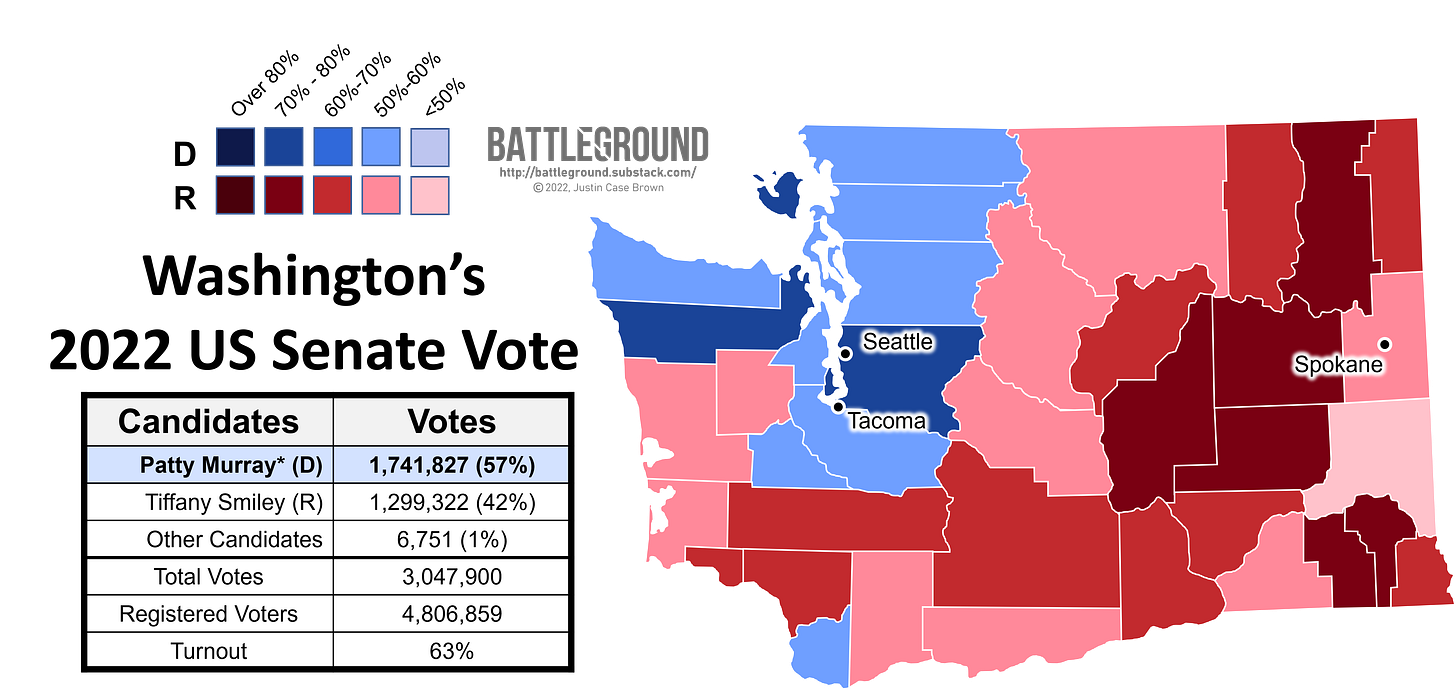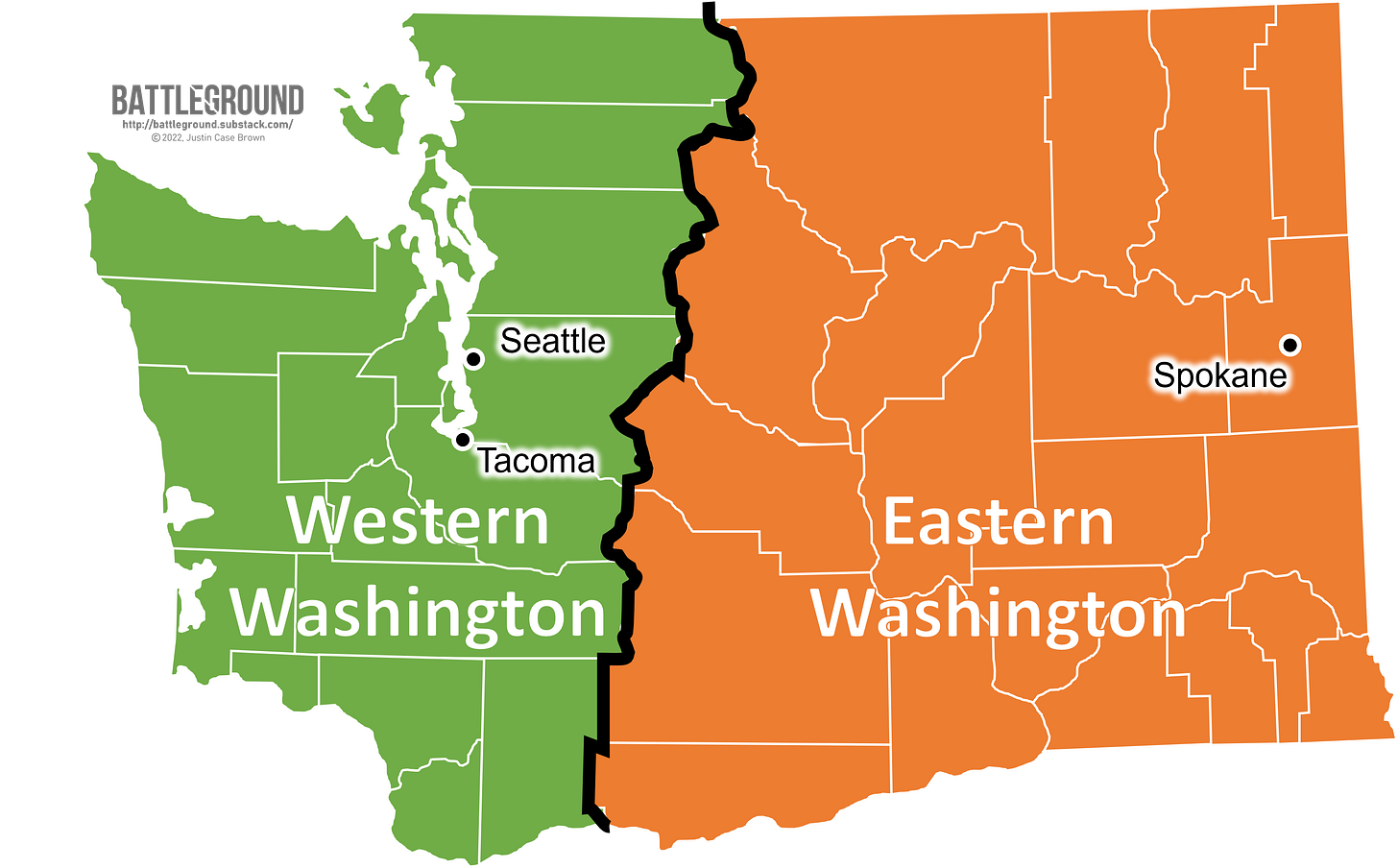Washington State's Election Results Show a Widening East-West Divide
With a surprising win in WA-3, Democrats control all US House seats bordering the Pacific Ocean.
Topline Takeaways
While Washington state has held a longstanding political divide between the eastern and western halves of the state, recent midterm election results suggest that this gap is widening.
Nearly all of Washington’s surviving US House incumbents saw their winning margins increase when compared to the 2020 election, suggesting that voters across the state are increasingly entrenched within their respective parties.
Democrats pulled off a shocker by flipping WA-3 in a race that most pundits expected Republicans to win.
Washington State’s East-West Divide
Washington state’s geographical and political contours are shaped by the Cascade Mountains. The state is split down its center by the Cascade Range, giving the state two distinct climates. Eastern Washington falls in the Cascade’s rain shadow, producing a dry, semi-arid climate. The western half of the state is almost the exact opposite: a rainy, oceanic climate that the Pacific Northwest is known for. While the state is split roughly evenly when looking at land area, the western half of the state holds roughly 80% of the state’s voters.
These opposing climates help breed opposing political views as Eastern Washington is dominated by Republicans and Western Washington dominated by Democrats. WA-4 and WA-5, the two congressional districts of Eastern Washington, haven’t been represented by Democrats since the early 1990s. Meanwhile, Democrats just made history with recent flip of WA-3: this marks the first time since the early 2000s that Washington Democrats control every House seats bordering the Pacific Ocean. (This is also the first time in American history where Democrats across Washington, Oregon and California control every single US House seat that borders the Pacific Ocean.)
WA-3: Marie Gluesenkamp Perez v. Joe Kent
Heading into the midterm election, most political pundits expected Republicans to hold on to Washington’s 3rd congressional district. Many believed that the Republican candidate, Joe Kent, would prevail as he ousted incumbent Rep. Jaime Herrera Beutler in the primary.
Enter Marie Gluesenkamp Perez, a working class Democrat that owns an auto-repair shop. Rather than dwelling on hazy progressive ideals like defunding the police or pushing the Green New Deal, Gluesenkamp Perez won the election by focusing on “pocketbook” issues. She connected lofty social issues with the way average voters experience them in their day-to-day lives; like focusing on lowering prescription drug costs, increasing child tax credits to help families afford child care, and investing in vocational schools to strengthen educational alternatives to expensive private colleges.
Her opponent, Joe Kent, painted himself as “an America First” Republican who’s pro-life and a 2nd amendment advocate. While WA-3 is considerably more conservative than all of the other Western Washington districts, it clearly wasn’t conservative enough to elect a Trump-endorsed candidate. Results from this election help explain (soon to be former) Rep. Jaime Herrera Beutler’s vote to impeach Donald Trump. Earlier this year, Beutler’s impeachment vote was used to explain why she lost the primary to Kent and many believed her loss was a sign that WA-3 was firmly in Republicans’ pocket. Instead, Beutler’s moderate approach (when compared to her Republican colleagues) was simultaneously a liability amongst the party’s base and an asset in the general election. Let’s be clear, Beutler was not a political newcomer, she will have served for a total of 12 years when she leaves office at the beginning of next month. She understood that her district only barely supported Donald Trump in 2020 by a slim 4-point margin. Going full MAGA like Joe Kent was never going to work here and it turned off just enough voters to allow Gluesenkamp Perez to notch a win by a slim margin of barely 3,000 votes.
More from Battleground on Washington State
Racial justice was front and center during Washington state’s most recent round of redistricting. See how mapmakers used the process to give a stronger voice to the state’s indigenous voters.
Liberal Republicans? Conservative Democrats? Learn how Washington’s political history was shaped by political dynamics that have since disappeared.






